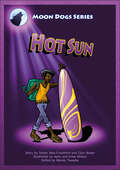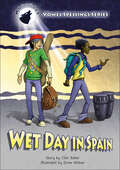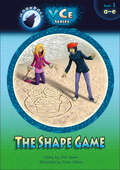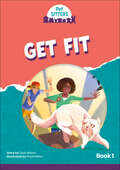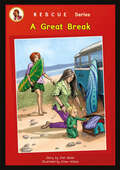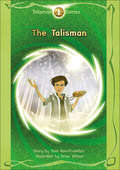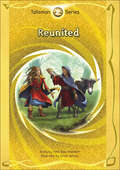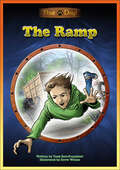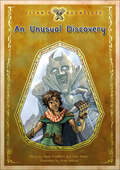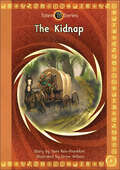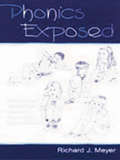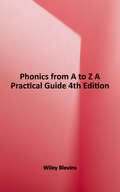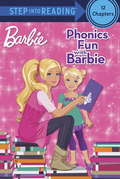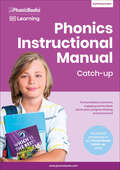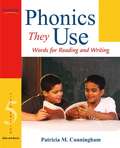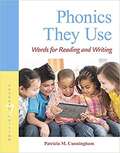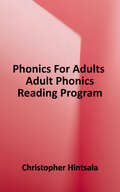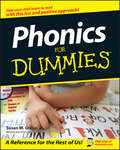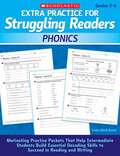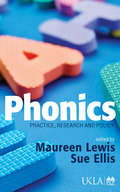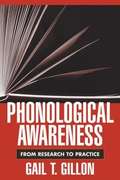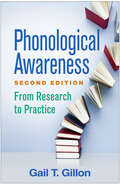- Table View
- List View
Phonic Books Moon Dogs Set 2: Decodable Books for Older Readers (CVC Level, Consonant Blends and Consonant Teams) (Phonic Books Catch-Up Decodable Readers)
by Phonic BooksPhonic Books Moon Dogs Set 2 comprises eight books designed for older children at the very early stages of reading. Contains contemporary illustrations and a story line based on the adventures of a group of teenage friends in a band. Moon Dogs Set 1 introduces sounds gradually at CVC level with one line of text on each page, Set 2 introduces consonant blends and consonant digraphs. Moon Dogs Set 3 introduces two spellings for a vowel sound. The Moon Dogs Extras set runs parallel to Set 1 and provides crucial further practice for the sounds of the alphabet at CVC level text. Moon Dogs VCe Spellings focuses on silent or 'magic' e spellings. Book 1: Hot Sun (CVC) Book 2: The Old Lamp (VCC, CVCC) Book 3: The Glum Cat (CCVC) Book 4: Jed Swims (CCVCC) Book 5: Chips for Lunch (ch) Book 6: A Wish (sh) Book 7: The Thing on the Path (th, ng) Book 8: Drum Sticks (ck, qu) Accompanying photocopiable activities for word building, reading, spelling and comprehension can be found in Moon Dogs Set 2 Activities.
Phonic Books Moon Dogs Set 3 Vowel Spellings: Decodable Books for Older Readers (Two Spellings for a Vowel Sound) (Phonic Books Catch-Up Decodable Readers)
by Phonic BooksPhonic Books Moon Dogs Set 3: Vowel Spellings comprises 14 books designed for older children at the very early stages of reading. Contemporary illustrations and a story line based on the adventures of a group of teenage friends in a band. Moon Dogs Set 3 introduces two spellings for a vowel sound. Moon Dogs Set 1 introduces sounds gradually at CVC level with one line of text on each page, Set 2 introduces consonant blends and consonant digraphs. The Moon Dogs Extras set runs parallel to Set 1 and provides crucial further practice for the sounds of the alphabet at CVC level text. Moon Dogs VCe Spellings focuses on silent or 'magic' e spellings. Book 1: Wet Day in Spain (ai, ay) Book 2: Lost in the Street (ee, ea) Book 3: The Boat Trip (oa, ow) Book 4: Birthday Lunch (ur, ir) Book 5: Matt's Bad Head (e, ea) Book 6: Mouse in the House (ow, ou) Book 7: A Gloomy Room (oo, ue) Book 8: A Wild Night (igh, i) Book 9: A Jog in the Woods (oo, oul) Book 10: An Awful Day (a, aw) Book 11: Out of Oil (oy, oi) Book 12: Beach Party (ar) Book 13: A Scary Haircut (air, are) Book 14: Steer Clear (ear, eer) Accompanying photocopiable activities for word building, reading, spelling and comprehension, grammar and vocabulary can be found in Moon Dogs Set 3: Vowel Spellings Activities.
Phonic Books Moon Dogs VCe Spellings: Decodable Books for Older Readers (Silent "e") (Phonic Books Catch-Up Decodable Readers)
by Phonic BooksPhonic Books Moon Dogs VCe Spellings comprises six books and focuses on silent or 'magic' e spellings and is designed for older children at the early stages of reading. The books contain contemporary illustrations and a story line based on the adventures of a group of teenage friends in a band. Moon Dogs Set 1 introduces sounds gradually at CVC level with one line of text on each page, Set 2 introduces consonant blends and consonant digraphs. Moon Dogs Set 3 introduces two spellings for a vowel sound. The Moon Dogs Extras set runs parallel to Set 1 and provides crucial further practice for the sounds of the alphabet at CVC level text.Book 1: The Shape Game (a-e)Book 2: These Things (e-e)Book 3: Bike Ride (i-e)Book 4: A Good Nose (o-e)Book 5: A Useful Bag (u-e)Book 6: A Place to Hide (All spellings)Accompanying photocopiable activities for word building, reading, spelling and comprehension can be found in Moon Dogs VCe Spellings Activities.
Phonic Books Pet Sitters: Decodable Phonic Books for Older Readers (CVC, Alternative Consonants and Consonant Digraphs, Alternative Spellings for Vowel Sounds - ai, ay, a-e, a) (Phonic Books Catch-Up Decodable Readers)
by Phonic BooksLearn how to read with these decodable Phonic Books for older readers.Phonic Books Pet Sitters are older reader books that introduce children to a few letters and sounds at a time. The pack of 12 decodable books is aimed at older children in the very early stages of reading and in need of support, teaching different letter patterns through a series of stories. Dedicated books in each stage break down phonics practice while offering different stories, encouraging independent reading from the start for ages 9-12 or Grades 4-6. It starts at at CVC level and introduces adjacent consonants and consonant digraphs, with gentle progression throughout the set.For example:Books 1 & 2: CVC, CVCC, CCVCBooks 3: CCVCCBook 4: sh, ch, tch, thBook 5: ck, ng, qu, wh, le, -edThis catch-up reader book series features: - A pack of 12 decodable books each containing a story with different phonic letters and sounds.- Each unit introduces new letters and sounds through sounding them out (sat, s - a - t).- Reading material aimed at older children who need support with their reading.- CVC, VCC, CVCC, CCVC, and CCVCC words, introducing adjacent consonants, consonant diagraphs and suffixes like -ed.Each 16-page book contains: - Reading practice/vocabulary- Contents page - Story pagesWhat is phonics?Phonics is a way of teaching children to read through understanding the sounds that individual letters make and blending them to make a word. Children can learn to read using this skill to decode new words. Phonic Books specializes in decodable, systematic books supporting this structured literacy instruction.
Phonic Books Rescue: Decodable Books for Older Readers (Alternative Vowel Spellings) (Phonic Books Catch-Up Decodable Readers)
by Phonic BooksWhen disaster strikes, Erin and her friend Danny must rescue Erin's baby brother Jack. Phonic Books Rescue introduces alternative vowel spellings. Rescue comprises ten books and follows the same phonic progression as Phonic Books Talisman 1 and Phonic Books Island Adventure and can be used in parallel to consolidate phonemic knowledge and reading skills.Book 1: A Great Break (ay, ai, a, a-e, ea, ey)Book 2: The Search Begins (ee, ea, y, e, ie, e-e, ei)Book 3: Rainbow Fish (ow, oa, o, oe, o-e)Book 4: On With the Search (er, ir, ur, or, ear)Book 5: A Long Way Down (ow, ou & oi, oy)Book 6: A Gruesome Monster (oo, ue, u-e, ew, ou, u)Book 7: Time is Running Out! (igh, ie, i-e, i, y)Book 8: An Awful Planet (aw, awe, a, au, al, ough)Book 9: No Time to Spare (air, are, ear, ere, eir)Book 10: Dark Times (ar)Accompanying photocopiable activities for word building, reading, spelling and comprehension can be found in Rescue Activities.
Phonic Books Talisman 1: Decodable Books for Older Readers (Alternative Vowel Spellings) (Phonic Books Catch-Up Decodable Readers)
by Phonic BooksZak is given a strange gift with special powers by his grandfather, but someone else wants it and will stop at nothing to get it. Phonic Books Talisman 1 introduces alternative vowel spellings. Talisman 1 comprises ten books and follows the same phonic progression as Phonic Books Dragon Eggs, Phonic Books Rescue and Phonic Books Island Adventure and can be used in parallel to consolidate phonemic knowledge and reading skills.Book 1: The Talisman (ay, ai, a, a-e, ea, ey)Book 2: Stampede! (ee, ea, y, e, ie, e-e, ei)Book 3: Shadow in the River (ow, oa, oe, o-e, o)Book 4: Deep Sea Danger (er, ir, ur, or, ear)Book 5: Hounded in the Snow (ow, ou & oi, oy)Book 6: Death at Noon (oo, ue, u-e, ew, ou, u)Book 7: A Cry in the Dark (igh, ie, i-e, i, y)Book 8: Attack at Nightfall (a, aw, awe, au, al, ough)Book 9: Mountain Scare (air, are, ear, ere, eir)Book 10: The Dark Master (ar)Accompanying photocopiable activities for word building, reading, spelling and comprehension can be found in Talisman 1 Activities.
Phonic Books Talisman 2: Decodable Books for Older Readers (Alternative Vowel and Consonant Sounds, Common Latin Suffixes) (Phonic Books Catch-Up Decodable Readers)
by Phonic BooksThe Dark Master is creating a new Talisman and all of mankind is at risk. Zak must work quickly if he is to save the world. Phonic Books Talisman 2 comprises ten books introducing alternative spellings and vowel and consonant sounds and common Latin suffixes.Book 1: Reunited ('ue': u, ue, u-e, ew)Book 2: Trouble in the Woods ('u': u, o, ou; 'o': o, a, ou, au)Book 3: Certain Death ('s': s, ss, se, c, ce, sc, st)Book 4: The Fossil ('l': l, ll, le, al, el, il, ol)Book 5: Legends of the Gorge ('j': j, g, ge, dge, dj)Book 6: The Sphinx ('f': f, ff, ph, gh)Book 7: Sticky Adventure ('cher': ture)Book 8: Dangerous Direction ('shun': tion, tian, sion, ssion, cian)Book 9: Zak Tries Martial Arts ('shul': tial, cial; 'shus': cious, ious, tious)Book 10: The Dark Master's Vision ('zhun': sion; 'zher' sure)Accompanying photocopiable activities for word building, reading, spelling and comprehension can be found in Talisman 2 Activities.
Phonic Books That Dog!: Decodable Books for Older Readers (CVC, Consonant Blends and Consonant Teams) (Phonic Books Catch-Up Decodable Readers)
by Phonic BooksBen has always wanted a dog. One day a scruffy stray follows him home. Will he get to keep him? This action-packed story takes the reader from CVC and CVCC word text through to consonant blends, consonant teams and suffixes -ed and -ing. Phonic Books That Dog! comprises 12 decodables for older readers who can read simple CVC words. That Dog! shares the same phonic progression as Phonic Books Magic Belt and can be used in parallel to consolidate phonemic knowledge and reading skills.Book 1: The Ramp (CVC, CVCC)Book 2: The Lost Dog (CVCC)Book 3: No Dogs! (CVCC)Book 4: Drop It! (CCVC and -ed)Book 5: Ben Gets Strict (CCVCC)Book 6: Catch Me! (ch and tch)Book 7: Fishing (sh)Book 8: Cherished Things (th)Book 9: Good and Bad Luck (ck and qu)Book 10: The Long, Thin Boat (ng)Book 11: Shopping for Props (wh and -ing)Book 12: Dog in Trouble (le)Accompanying photocopiable activities for word building, blending, spelling and comprehension can be found in That Dog! Activities.
Phonic Books Titan's Gauntlets: Decodable Books for Older Readers (Alternative Vowel and Consonant Sounds, Common Latin Suffixes) (Phonic Books Catch-Up Decodable Readers)
by Phonic BooksFinn must harness the power of the Gauntlets if he is to awaken the Titan and stop the Evil Winged One from destroying the world. Phonic Books Titan's Gauntlets comprises ten books covering alternatives for vowel and consonant sounds and common Latin suffixes. Book 1: An Unusual Discovery (u, ue, u-e) Book 2: A Time for Courage (u, o, ou) Book 3: Scepter of Malice (s, ss, se, c, ce) Book 4: The Coral Palace (l, ll, le, al) Book 5: Strange Energy (j, g, ge) Book 6: Phantoms of the Fog (f, ff, ph) Book 7: Unnatural Creatures (-ture) Book 8: A Strange Location (-tion) Book 9: Artificial Heart (-cial, -tial) Book 10: Shattered Illusions (-sion) Accompanying photocopiable activities for reading, spelling and comprehension can be found in Titan's Gauntlets Activities.
Phonic Books Totem: Decodable Books for Older Readers (CVC, Consonant Blends and Consonant Teams, Alternative Spellings for Vowel Sounds - ai, ay, a-e, a) (Phonic Books Catch-Up Decodable Readers)
by Phonic BooksZak's adventures begin when he's captured by two men and his shepherd's staff acquires special powers. Starting at CVC level, the books progress through consonant blends, consonant teams and alternative vowel spellings.Phonic Books Totem comprises 12 books and shares the same phonic progression as the Phonic Books Alba series and can be used in parallel to consolidate phonemic knowledge and reading skills. (CVC, CVCC, CCVC, CCVCC, sh, ch, tch, th, ck, ng, qu, wh, le, -ed, ai, ay, a-e, a, ee, ea, e, y, ey, o-e, ow, oa, o, er, ir, ur, ow, ou, igh, i-e, y, i, oo, ew, u-e, u).Book 1: The Kidnap (CVC, CVCC)Book 2: The Gift (CVC, CVCC, CCVC)Book 3: On the Brink of Death (CVC, CVCC, CCVC, CCVCC)Book 4: The Shadow on the Cliff (sh, ch, th)Book 5: Bad Luck (ck, ng, qu, wh)Book 6: Dangers on the Plain ('ae': ai, ay, a-e, a)Book 7: Valley of Dreams ('ee': ee, ea, e, y, ey)Book 8: The Monster Below ('oe': o-e, ow, oa, o)Book 9: Murky Waters ('er': er, ir, ur)Book 10: Danger All Around ('ow': ow, ou)Book 11: Jungle Fright ('ie': igh, i-e, y, i)Book 12: Hooves! ('oo': oo, ew, u-e, u)Accompanying photocopiable activities for segmenting, comprehension, blending and writing can be found in Totem Activities.
Phonics Exposed: Understanding and Resisting Systematic Direct Intense Phonics Instruction
by Richard J. MeyerWhat are the implications of teaching phonics via a systematic direct intense program that mandates all children to experience the same scripted lesson at the same time? This book addresses the question through an in-depth play-by-play description of a phonics lesson as it occurred in a real classroom, followed by chapters that look at it from different angles by "zooming in" on one facet to analyze it closely: *Reading. What is reading? What definition of reading is presented (implicitly) in the phonics lesson? What do competing definitions from the reading research literature say about how important phonics rules are and how they are used by readers and teachers of reading? *Teacher knowledge. What is the role and the place of teacher knowledge as it relates to the lesson? What are the skills a teacher has and needs to use in a lesson that is completely scripted ? *The children. What are their roles and positions during the lesson? What are they learning? *Curriculum. Where does the phonics curriculum come from? Curriculum in general? Who does it serve and how? What is its purpose? * Culture. What is the role of culture in the lesson? How do cultural differences and culturally relevant pedagogy relate to the scripted phonics lesson? *Politics and ideology. Why and how is everything that happens in schools political? How are scripted lessons and resistance to them, forms of political action? *Teacher professionalism. How can teachers act in order to maintain academic freedom expressed as professional decision making in classrooms? The author of this book is not neutral. He presents the difficulties a teacher encounters in implementing mandated systematic, direct, intense phonics instruction and children who are confused and frustrated by it. But at the same time he constantly presents hope in the form of smart teachers, curious children, and possibilities for taking action that can lead to change. His direct, accessible writing style stimulates thought and discussion.
Phonics From A To Z: A Practical Guide
by Wiley BlevinsLeading phonics expert Wiley Blevins has updated his best-selling classic to include the latest in phonics instruction and the science of reading, as well as current research on handwriting and phonemic awareness. This revised edition also offers ideas for maximizing your scope and sequence, practical tips for creating sound walls, a decodable text routine for building comprehension, strategies for differentiating during whole-group lessons while better targeting small-group work, and more.
Phonics Fun with Barbie (Barbie)
by Karen Wolcott Jennifer Liberts WeinbergBarbie makes phonics fun in this book, which includes twelve full-color chapters and a letter to parents. Each chapter is developed by an educational expert and focuses on specific skills and sounds that are essential to reading success. Little girls will love learning to read with Barbie!
Phonics Instructional Manual Catch-up: The foundations of phonics, engaging activity ideas, lesson plans, progress tracking and assessment (Phonic Books Catch-Up Decodable Readers)
by Phonic BooksThis teacher guide is an essential resource for using the Phonic Books Catch-up range for intervention sessions with older readers.This guide designed for teachers provides an overview of phonics, including explanations of core phonic concepts, terms and methodologies; an overview of the Phonic Books programme; assessment; and guidance for pronunciation and teaching of high-frequency words. There are also structured lesson plans for varying amounts of time. These plans are full of engaging and effective activities which are easy to implement.This phonics catch-up teacher guide features: A time-saving guide for teachers to help with lesson planning and preparation.Teaching material aimed at children aged 9-12.Jargon-busting explanations and step-by-step easily implemented lessons, especially for anyone new to teaching phonics.Activities included, such as word building and word chains, that will engage pupils and implement previously taught skills.This guide conveniently breaks down each lesson into five main sections: Revision, Preparation, Application, Consolidation and Tracking Progress. This enables each lesson to meet the phonics requirements, as well as more general literacy requirements and ensures pupils are concurrently learning how to read for meaning from the start.What is phonics?Phonics is a way of teaching children to read by understanding the sounds that individual letters make and blending them to make a word. Children can learn to read using this skill to decode new words. Phonic Books specializes in publishing decodable, systematic books supporting this structured literacy instruction.
Phonics They Use: Words for Reading and Writing (5th edition)
by Patricia M. CunninghamWritten by an outstanding scholar, Phonics They Use seamlessly weaves together the complex and varied strategic approaches needed to help students develop reading and spelling skills. Long-positioned and long-respected as a bestseller by both pre-service and practicing teachers of reading, this affordable text offers a coherent collection of practical, hands-on activities that provide a framework for teaching phonics. The Fifth Edition continues to emphasize that what matters is not how much phonics students know but what they actually use when they need phonics for decoding a new word, for reading and spelling a new word, and for writing. Rather than subscribe to a single theory, Pat Cunningham stresses a balanced reading program--incorporating a variety of strategic approaches--tied to the individual needs of children. Packed with new activities and strategies for teaching reading, this book is an invaluable resource for any new or veteran teacher. Now teachers have access to a new grade-level series Making Words that offers fresh multi-level activities and lessons for the kindergarten through fifth grade classroom. Based on the active and innovative approach to making words that teachers and their students have grown to love in Phonics They Use, this new series is the best resource you can have on hand for motivating your students to learn words! Take a Peek at What's New to the Edition! New Chapter on Making Words in Kindergarten (Ch. 4)describes and provides sample lesson plans on how teachers can make each kindergarten student a letter of the alphabet, using a big letter card, to teaching them how to begin to form words. New Chapter on Making Words in Upper Grades (Ch. 11)describes and provides sample lessons on how making words has been adapted for use of older students in upper grades, by emphasizing the prefixes, suffixes, roots and spelling changes that are the important decoding and spelling patterns for polysyllabic words. Inclusion of hints and suggestions for English Language Learners scattered throughout the chapters, which help make phonics and spelling instruction more successful for ELLs as they learn to read and write. These "For English Language Learner" boxes include a variety of ways teachers have adapted the Phonics They Use activities to include their children learning English.
Phonics They Use: Words for Reading and Writing (Making Words Series)
by Patricia CunninghamThe long-standing, bestselling classic of strategies and hands-on activities for teaching phonics. <p><p> In the new edition of this popular book, author and scholar Patricia Cunningham seamlessly weaves together the complex and varied strategic approaches needed to help students develop reading and writing skills. With its focus on how students use phonics to read and write, not just how much phonics a student knows, Phonics They Use includes numerous developmentally appropriate activities for helping students with fluency, rhyme-based decoding, spelling, and more. <p><p>Updated throughout, this new edition devotes increased attention to morphology as the key to decoding, spelling, and building meaning for big words; includes a new set of lessons, Compound Combos, designed to help teachers introduce morphology to students; introduces a list of 50 key words, the Nifty Thrifty Fifty, which contain a common example for all the common prefixes, suffixes, and spelling changes; includes a new chapter presenting a series of lessons on how to gradually teach these 50 words and how manipulating the parts of these 50 words can help decode, spell, and unlock the meaning of over 300 other words; and presents a new chapter on phonics and spelling interventions for older struggling readers.
Phonics for Adults: Adult Phonics Reading Program
by Christopher HintsalaMaster the art of phonics and learn to pronounce English like a native with this ultimate adult learning guide. <p><p>Are you struggling to develop your English pronunciation skills? Do you want to discover how you can learn to speak like a native in a fast, efficient, and fun way? Or are you looking for an all-in-one phonics guide that’s geared towards adults? Then this book is for you! <p><p>Specially crafted with a comprehensive overview of English phonics for adults, this brilliant educational workbook combines practical, easy-to-understand lessons with a professional-quality phonics video course that’s designed to help you master your pronunciation and develop an authentic, convincing American English accent with ease. Perfect for learners of all backgrounds and skill levels, you’ll join author and phonics teacher Christopher Hintsala—founder of the popular Youtube channel Listen and Learn English—as you discover essential skills including accent training, correct pronunciation, and writing with tons of simple stories and sentences. With a breakdown of 5 levels that covers both common and challenging vowels and consonant pairs, Phonics For Adults provides you with an intuitive and step-by-step guide to rapidly increasing your confidence with English.
Phonics for Dummies
by Susan M. GreveFeatures kid- and parent-friendly tips and activities The fun and easy way to grasp the ABCs of reading Want to introduce your child to reading, or strengthen your child's reading skills? This fun and entertaining guide shows you how to use phonics as an easy and engaging path to reading. Phonics For Dummies contains tips on mastering letter sounds in reading, activities to engage your child's enthusiasm, and advice for making reading interesting and fun. Discover how to: Use phonics to learn to read Improve reading and spelling skills Master unusual sounds and spellings Build your child's vocabulary Play games that encourage progress All this on the audio CD: Dozens of letter sounds in friendly lessons Keywords to help your child with reading and spelling Easy examples and tips for your child to follow Note: CD-ROM/DVD and other supplementary materials are not included as part of eBook file.
Phonics, Level A
by Lesley Mandel Morrow Marie Garman Patricia Maureen MountA publisher-supplied textbook
Phonics, Level C
by Lesley Mandel Morrow Marie Garman Patricia Maureen MountA publisher-supplied textbook
Phonics: Getting it Right in a Week (Getting it Right in a Week)
by Angela Gill David WaughIs your knowledge and understanding of systematic synthetic phonics secure? Do you understand the difference between graphemes and phonemes? Is your phonics teaching both engaging and interactive? Systematic synthetic phonics is central to the teaching of early reading and is a key element in Ofsted inspections. For your pupils, learning about phonics represents an integral part of their journey to becoming successful readers and writers. This book offers you tried and tested ideas for developing an understanding of phonics and the development of effective pedagogy. Designed to be read over a week, it is divided into seven concise chapters detailing clear strategies, examining the strategy in action and summarising the relevant underpinning theory.
Phonics: Motivating Practice Packets That Help Intermediate Students Build Essential Decoding Skills to Succeed in Reading and Writing (Extra Practice for Struggling Readers)
by Linda BeechDozens of practice pages that give older, struggling readers multiple opportunities to review and really learn common, tricky words that are not easily decodable, recognize and reinforce must-know phonic elements, and hone word-study skills. With repeated practice, students develop automaticity and help become more fluent readers. Reviews basic word-study techniques. Improves automaticity. Boosts reading comprehension. Perfect for independent practice.
Phonics: Practice, Research and Policy (Published in association with the UKLA)
by Maureen Lewis Susan J EllisPhonics: Practice, Research and Policy unravels the controversy surrounding phonics which currently characterises much of the discussion about reading standards and teaching reading. Bringing some much-needed balance to the debate - the book offers genuinely focused advice on how to make sense of the various theories and on their applications in practice, helping teachers to find the right practical solutions to suit the children in their settings. The book includes chapters on: - How children learn to read and how phonics helps - The role of early phonics teaching - Classroom approaches to phonics teaching - Involving parents and carers - Speaking and phonological awareness - Spelling links - Staff development - Responses to the Rose Review on Early Reading. It will be essential reading for student teachers on initial training courses, and for more experienced staff in a range of school settings.
Phonological Awareness
by Gail T. GillonThis unique resource provides a comprehensive review of current knowledge about phonological awareness, together with practical guidance for helping preschoolers to adolescents acquire needed skills. Up-to-date findings are synthesized on the development of phonological awareness; its role in literacy learning; and how it can be enhanced in students at risk for reading difficulties and those with reading disorders or speech or language impairments. Of particular value to general and special educators and speech language professionals, the book's clear recommendations for assessment and intervention show how to translate the research into day-to-day teaching and clinical practice.
Phonological Awareness, Second Edition: From Research to Practice
by Gail T. GillonTranslating cutting-edge research into practical recommendations for assessment and instruction, this book has helped thousands of readers understand the key role of phonological awareness in the development of reading, writing, and spelling. It clearly shows how children's knowledge about the sound structure of spoken language contributes to literacy acquisition. Evidence-based strategies are described for enhancing all learners' phonological awareness and effectively supporting those who are struggling (ages 3–17). The book discusses ways to tailor instruction and intervention for a broad range of students, including English language learners (ELLs) and those with reading or language disorders. New to This Edition: *Incorporates over a decade of important advances in research, assessment, and instruction. *Chapter on ELLs, plus additional insights on ELLs woven throughout the book, including new case studies. *Chapter on spelling development. *Significantly revised coverage of children with complex communication needs.
